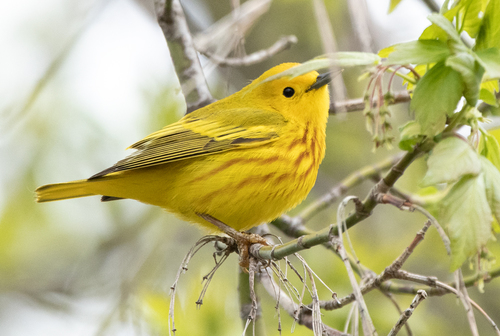
Yellow Warbler
The Yellow Warbler (Setophaga petechia) is a vibrant, small songbird renowned for its bright yellow plumage and cheerful song. It plays a crucial role in controlling insect populations, particularly in riparian and wetland habitats. This widespread species has a remarkable adaptability, evident in its diverse subspecies and extensive breeding range across the Americas. While generally common, some populations face threats from habitat loss and brood parasitism by the Brown-headed Cowbird. The Yellow Warbler holds no particular widespread cultural significance, but its bright color and lively presence make it a favorite among birdwatchers.
11-13 cm
Length
16-21 cm
Wingspan
Least Concern
Conservation Status
Distribution
Breeds across North America, from Alaska and Canada south to Mexico and the Caribbean. Migrates to Central and South America for the winter. Altitudinal range varies from sea level to over 2,500 meters.
Lifespan
Typically 2-3 years in the wild, but some individuals can live up to 10 years.
Yellow Warbler's Habitat
Habitat Types
Riparian thickets, Wetlands, Marshes, Open woodlands, Gardens
Climate Zones
Temperate, Subtropical, Tropical
Adaptations
Their preference for dense, shrubby vegetation near water provides ample nesting sites and insect prey. Their small size allows them to maneuver easily within dense foliage.
Variations
There are many recognized subspecies (over 30), broadly grouped into three categories: the migratory aestiva group (breeding in North America), the resident petechia group (in the Caribbean), and the resident or partially migratory erithachorides group (in coastal Central and northern South America). These groups differ in plumage (especially the presence and extent of reddish streaking or hoods) and song.
Appearance
Breeding Plumage
Breeding males are bright yellow overall with reddish streaks on the breast and flanks. Females and non-breeding males are duller yellow, with less pronounced or absent streaking.
Seasonal Feather Changes
After breeding, adults molt into a duller non-breeding plumage, similar to that of females and immatures.
Sex Based Plumage Differences
Significant; males are much brighter yellow than females, especially during the breeding season.
Notable Features
Bright yellow plumage, Reddish streaks on the breast (in breeding males), Black eyes, Thin, pointed bill
Diet and Feeding
Primary Foods
Insects, Spiders, Caterpillars, Beetles, Flies
Foraging Behavior
Actively gleans insects from leaves and branches, often hovering briefly to pick prey. They may also fly out to catch insects in mid-air.
Specializations
Their thin, pointed bill is well-suited for picking small insects from foliage.
Seasonal Diet Variations
Diet is primarily insects during the breeding season. During migration and winter, they may also eat some fruits and berries.
Behavior
Social Structure
Generally solitary or in pairs during the breeding season. May form small flocks during migration and winter.
Communication
Variety of chip notes, High-pitched 'sweet-sweet-sweet' song (males), Contact calls between pairs
Migration
Migratory populations undertake long-distance flights between breeding and wintering grounds. They often migrate at night.
Territorial or Group Behaviors
Males are highly territorial during the breeding season, defending their territory against other males through song and aggressive displays. They are less territorial during migration and winter.
Conservation
Threats
Habitat loss (especially riparian areas), Brood parasitism by Brown-headed Cowbirds, Pesticide use, Collisions with buildings during migration
Protection Programs
Habitat restoration projects, Cowbird control programs (in some areas)
Local National Laws
Protected under the Migratory Bird Treaty Act in the United States and Canada.
Population Trend
Generally stable, but some populations have declined.
Population Estimates
Global population estimated to be around 90 million individuals.
Interesting Facts
They are one of the most widespread warbler species in North America.
Their adaptability to various habitats contributes to their wide distribution.
Yellow Warblers have a unique way of dealing with cowbird parasitism.
They often build a new nest layer on top of the cowbird eggs, effectively burying them.
The different subspecies groups have distinct appearances.
Some tropical subspecies have reddish caps or hoods, unlike the all-yellow heads of the North American breeders.
Faqs about Yellow Warbler
What is the best way to attract Yellow Warblers to my yard?
Provide dense, shrubby vegetation, especially near water sources. Avoid using pesticides.
Do Yellow Warblers mate for life?
They are typically monogamous during a single breeding season, but may choose different partners in subsequent years.
How can I tell the difference between a male and a female Yellow Warbler?
Breeding males are bright yellow with reddish streaks on their breast, while females are duller yellow and lack the streaks.
Where can I find Yellow Warblers?
Yellow warblers can be found near open woodlands, and clusters of shrubbery. Oftentimes, they can be found near streams, lakes or marshes.
Copyright @ Nature Style Limited. All Rights Reserved.
 English
English